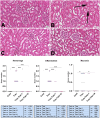Protective effects of tasimelteon on kidney injury in a traumatic brain injury rat model: a histopathological and immunohistochemical study
- PMID: 40576729
- PMCID: PMC12205017
- DOI: 10.1007/s00068-025-02915-6
Protective effects of tasimelteon on kidney injury in a traumatic brain injury rat model: a histopathological and immunohistochemical study
Abstract
Purpose: Traumatic brain injury (TBI) is a condition characterized by structural and functional damage to the brain following trauma and is a significant cause of mortality. Acute kidney injury (AKI) has been reported in patients with TBI and is a commonly encountered complication. This study examines the effect of tasimelteon (Tasi) application on kidney tissue in TBI rats by histopathological and immunohistochemical staining.
Methods: Forty male Wistar Albino rats weighing 300–350 g were randomly divided into four groups: Control group, Trauma group (Trau), Trau-Tasi-1 group (trauma-1 mg/kg Tasi intraperitoneally), and Trau-Tasi-10 group (trauma-10 mg/kg Tasi intraperitoneally). At the end of the experimental phase, after euthanasia, kidney tissue was collected for histopathological and immunohistochemical analyses.
Results: The results of histopathological and immunohistochemical staining demonstrate that brain trauma may induce kidney injury, while Tasi possesses the potential to ameliorate kidney lesions associated with TBI. It has been found that Trau-Tasi-10 is more effective in treatment compared to Trau-Tasi-1.
Conclusion: We observed Tasi’s kidney injury ameliorating activity in TBI rats through histopathological and immunohistochemical staining findings.
Supplementary Information: The online version contains supplementary material available at 10.1007/s00068-025-02915-6.
Keywords: Brain; Kidney; Pathology; Tasimelteon; Trauma.
Conflict of interest statement
Declarations. Ethical approval: All animal experiments and animal research were conducted in accordance with the animal research guidelines specified in the ARRIVE 2.0 Guide. The procedures conducted on rats were reviewed and approved by the Animal Experiments Local Ethics Committee of Suleyman Demirel University (Ethic No: 12.12.2024/15–415). Competing interests: The authors declare no competing interests.
Figures






Similar articles
-
Effects of traumatic brain injury on vascular response and fracture healing: an experimental study in a rat model.Acta Orthop Traumatol Turc. 2025 May 28;59(3):133-140. doi: 10.5152/j.aott.2025.23104. Acta Orthop Traumatol Turc. 2025. PMID: 40535310 Free PMC article.
-
Isolated Traumatic Subarachnoid Hemorrhage on Head Computed Tomography Scan May Not Be Isolated: A Transforming Research and Clinical Knowledge in Traumatic Brain Injury Study (TRACK-TBI) Study.J Neurotrauma. 2024 Jun;41(11-12):1310-1322. doi: 10.1089/neu.2023.0253. Epub 2024 Apr 11. J Neurotrauma. 2024. PMID: 38450561 Free PMC article.
-
Brain Injury and Ketamine study (BIKe): a prospective, randomized controlled double blind clinical trial to study the effects of ketamine on therapy intensity level and intracranial pressure in severe traumatic brain injury patients.Trials. 2025 May 28;26(1):177. doi: 10.1186/s13063-025-08835-5. Trials. 2025. PMID: 40437634 Free PMC article.
-
Renal Histopathological Changes in Coronavirus Disease 2019 Patients: A Systematic Review and Meta-analysis of Individual Patient Data.Saudi J Kidney Dis Transpl. 2021 Nov-Dec;32(6):1523-1544. doi: 10.4103/1319-2442.352410. Saudi J Kidney Dis Transpl. 2021. PMID: 35946265
-
Takotsubo cardiomyopathy in post-traumatic brain injury: A systematic review of diagnosis and management.Clin Neurol Neurosurg. 2022 Feb;213:107119. doi: 10.1016/j.clineuro.2021.107119. Epub 2022 Jan 4. Clin Neurol Neurosurg. 2022. PMID: 34998160
References
-
- Chawla LS, Seneff MG, Nelson DR, Williams M, Levy H, Kimmel PL, Macias WL. Elevated plasma concentrations of IL-6 and elevated APACHE II score predict acute kidney injury in patients with severe sepsis. Clin J Am Soc Nephrol. 2007;2:22–30. 10.2215/CJN.02510706. - PubMed
-
- Luu D, Komisarow J, Mills BM, Vavilala MS, Laskowitz DT, Mathew J, James ML, Hernandez A, Sampson J, Fuller M, Ohnuma T, Raghunathan K, Privratsky J, Bartz R, Krishnamoorthy V. Association of severe acute kidney injury with mortality and healthcare utilization following isolated traumatic brain injury. Neurocrit Care. 2021;35:434–40. 10.1007/s12028-020-01183-z. - PMC - PubMed
-
- Civiletti F, Assenzio B, Mazzeo AT, Medica D, Giaretta F, Deambrosis I, Fanelli V, Ranieri VM, Cantaluppi V, Mascia L. Acute tubular injury is associated with severe traumatic brain injury: in vitro study on human tubular epithelial cells. Sci Rep. 2019;9:6090. 10.1038/s41598-019-42147-4. - PMC - PubMed
-
- Lee S, Hwang H, Yamal JM, Goodman JC, Aisiku IP, Gopinath S, Robertson CS. IMPACT probability of poor outcome and plasma cytokine concentrations are associated with multiple organ dysfunction syndrome following traumatic brain injury. J Neurosurg. 2019;131:1931–7. 10.3171/2018.8.JNS18676. - PubMed
LinkOut - more resources
Full Text Sources

